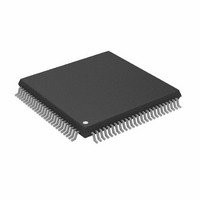AD8113JSTZ Analog Devices Inc, AD8113JSTZ Datasheet - Page 19

AD8113JSTZ
Manufacturer Part Number
AD8113JSTZ
Description
IC VIDEO CROSSPOINT SWIT 100LQFP
Manufacturer
Analog Devices Inc
Datasheet
1.AD8113JSTZ.pdf
(28 pages)
Specifications of AD8113JSTZ
Function
Video Crosspoint Switch
Circuit
1 x 16:16
Voltage Supply Source
Dual Supply
Voltage - Supply, Single/dual (±)
±4.5 V ~ 12.6 V
Operating Temperature
0°C ~ 70°C
Mounting Type
Surface Mount
Package / Case
100-LQFP
Crosspoint Switch Type
Analog
Control Interface
Parallel, Serial
Supply Voltage Range
4.5V To 5.5V, 4.5V To 12.6V
Operating Temperature Range
0°C To +70°C
Digital Ic Case Style
LQFP
Lead Free Status / RoHS Status
Lead free / RoHS Compliant
Available stocks
Company
Part Number
Manufacturer
Quantity
Price
Company:
Part Number:
AD8113JSTZ
Manufacturer:
ADI
Quantity:
160
Company:
Part Number:
AD8113JSTZ
Manufacturer:
Analog Devices Inc
Quantity:
10 000
Part Number:
AD8113JSTZ
Manufacturer:
ADI/亚德诺
Quantity:
20 000
late, and the bandwidth limitations of the devices will com-
pound. In addition, the extra devices will consume more current
and take up more board space. Once again, the overall system
design specifications will determine how to make the various
trade-offs.
Multichannel Video and Audio
The good video specifications of the AD8113 make it an ideal
candidate for creating composite video crosspoint switches. These
can be made quite dense by taking advantage of the AD8113’s
high level of integration and the fact that composite video requires
only one crosspoint channel per system video channel. There are,
however, other video formats that can be routed with the AD8113,
requiring more than one crosspoint channel per video channel.
Some systems use twisted-pair wiring to carry video or audio sig-
nals. These systems utilize differential signals and can lower costs
because they use lower cost cables, connectors, and termination
methods. They also have the ability to lower crosstalk and reject
common-mode signals, which can be important for equipment that
operates in noisy environments, or where common-mode voltages
are present between transmitting and receiving equipment.
In such systems, the audio or video signals are differential; there
are positive and negative (or inverted) versions of the signals.
These complementary signals are transmitted onto each of the
two wires of the twisted pair, yielding a first order zero common-
mode voltage. At the receive end, the signals are differentially
received and converted back into a single-ended signal.
REV. A
IN 48–63
IN 64 –79
IN 80–95
IN 96 –111
IN 00–15
IN 112 –127
IN 16–31
IN 32–47
1k
1k
1k
1k
1k
1k
1k
1k
16
16
16
16
16
16
16
16
Figure 12. Nonblocking 128 × 16 Audio Array (128 × 32 Blocking)
R
R
R
R
R
R
R
R
TERM
TERM
TERM
TERM
TERM
TERM
TERM
TERM
(8
AD8113
AD8113
AD8113
AD8113
AD8113
AD8113
AD8113
AD8113
RANK 1
128:32
AD8113)
8
8
8
8
8
8
8
8
8
8
8
8
8
8
8
8
1k
1k
1k
1k
1k
1k
1k
1k
1k
1k
1k
1k
1k
1k
1k
1k
–19–
8
1k
8
1k
8
1k
8
1k
When switching these differential signals, two channels are
required in the switching element to handle the two differential
signals that make up the video or audio channel. Thus, one
differential video or audio channel is assigned to a pair of
crosspoint channels, both input and output. For a single AD8113,
eight differential video or audio channels can be assigned to the
16 inputs and 16 outputs. This will effectively form an 8 × 8
differential crosspoint switch.
Programming such a device will require that inputs and outputs be
programmed in pairs. This information can be deduced through
inspection of the programming format of the AD8113 and the
requirements of the system.
There are other analog video formats requiring more than one
analog circuit per video channel. One two-circuit format that is
commonly being used in systems such as satellite TV, digital
cable boxes, and higher quality VCRs, is called S-video or Y/C
video. This format carries the brightness (luminance or Y)
portion of the video signal on one channel and the color (chromi-
nance, chroma, or C) on a second channel.
Since S-video also uses two separate circuits for one video channel,
creating a crosspoint system requires assigning one video channel
to two crosspoint channels as in the case of a differential video
system. Aside from the nature of the video format, other aspects
of these two systems will be the same. Stereo audio can also be
routed in a paired-channel arrangement similar to a two-channel
video system.
32:16 NONBLOCKING
(32:32 BLOCKING)
AD8113
AD8113
RANK 2
8
8
8
8
OUT 00 –15
NONBLOCKING
ADDITIONAL
16 OUTPUTS
(SUBJECT
TO BLOCKING)
AD8113














